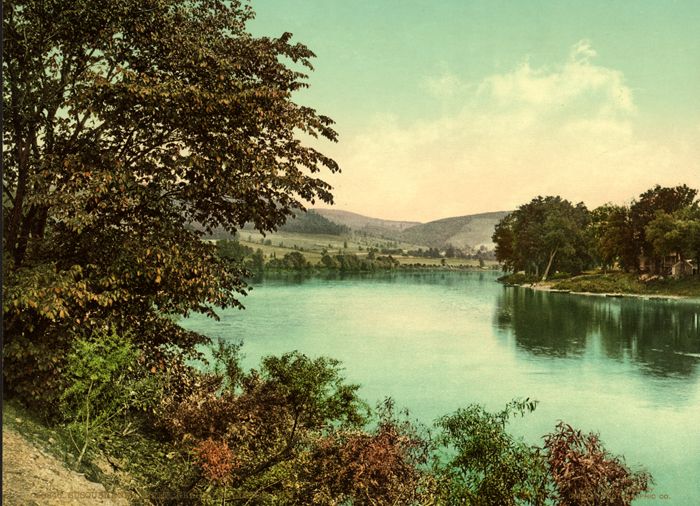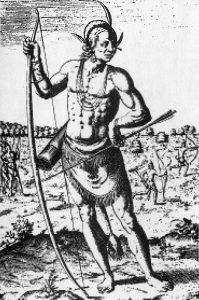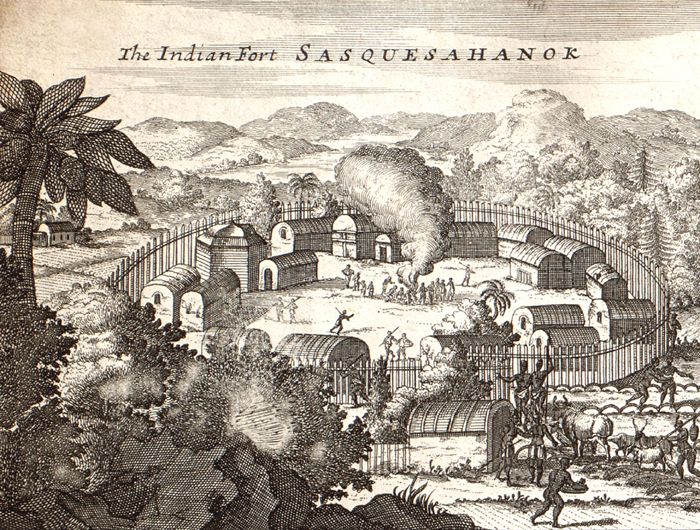The Susquehannock people, also called the Conestoga by the English, were an important Iroquoian-speaking tribe that formerly lived on the Susquehanna River and its branches, from the north end of the Chesapeake Bay in Maryland across Pennsylvania into southern New York. Evidence of their habitation has also been found in northern West Virginia.
The name Susquehannock is thought to have been an Algonquin word meaning the “people of the Muddy River.” The Susquehannock was a confederacy of up to 20 smaller tribes who occupied fortified villages along the Susquehanna River. They traded with other tribes along the Erie River in northern Ohio and the Huron and Neutral people of southern Ontario, Canada. Like other Iroquian tribes, they planted maize, beans, and squash in spring. Many of them temporarily moved south to the Chesapeake Bay in the summer to fish and gather shellfish before returning in the fall to harvest their crops and hunt.
They were independent and not part of any confederacy into the 1600s. They were described as noble, heroic, aggressive, warlike, and imperialistic. For years, before Europeans arrived, they were bitter enemies of the Iroquois Confederacy and were also thought to have warred with the Mahican from the central Hudson Valley. Susquehannock war parties routinely attacked the Lenape tribes along the Delaware River. They traveled down the Susquehanna River and raided the Nanticoke, Conoy, and Powhatan living on Chesapeake Bay. When Europeans first arrived, they were in alliance with the Algonquian tribes on the east shore of Chesapeake Bay and at war with those on the west shore. At this time, they are estimated to have numbered 5,000-7,000 people.
Their first European contact was in 1608 when Captain John Smith, from Jamestown, Virginia, was exploring the northern end of Chesapeake Bay. This first meeting was friendly, but Smith was wary because he already heard of the Susquehannock’s warlike reputation. Smith was especially impressed with their size, deep voices, and the variety of their weapons and was awed by their size, describing them as giants.
When Dutch and Swedish traders entered the region in the early 1600s, the Susquehannock traded and allied with them. By 1640, the Susquehannock had a monopoly on European firearms, further increasing the tribe’s power. These firearms were carefully not traded to Iroquois or Lenape tribes.
In 1642, the English Province of Maryland declared war on the Susquehannock, but with the help of the Swedes, the Susquehannock defeated the English in 1644. However, tensions between the tribe and the people of Maryland would continue until 1652, when a peace treaty was signed in return for arms and safety on the Susquehannocks’ southern flank. In exchange, the tribe ceded large territories on both shores of the Chesapeake Bay to Maryland. This decision was also made by the tribe because, at that time, the Iroquois Confederacy was attempting to expand their hunting grounds for the fur trade, and with the help of Maryland’s firearms, the Susquehannock fought off the Iroquois, and a brief peace followed.
But, it would not last for long. The Susquehannock were again at war with the powerful Iroquois Confederacy in 1658. By 1661, the Maryland colonists and the Susquehannock expanded their peace treaty into a full alliance against the Iroquois. During the next several years, the Susquehannock repelled several attacks by the Seneca, Cayuga, and Onondaga warriors of the western Iroquois.
The tribe reached its peak of power in the early 1670s and afterward began to decline due to infectious diseases and continued warfare. Drastically weakened by their losses, they were overwhelmed by their long-time enemies of the Iroquois Confederacy by 1678. Afterward, some small groups fled into western Pennsylvania and Ohio, with some joining with the Shawnee tribe. Others moved to New York, joining with the Seneca and Onondaga, who had a long tradition of adopting defeated enemies into their tribes. Others scattered, joining various other tribes.
By 1700, only 300 Susquehannock were remaining, and their rapid decline continued until the last 20 were massacred by a mob of colonists in 1763. There are, however, known descendants among the Iroquois and Lenape today.
Compiled by Kathy Alexander/Legends of America, updated February 2024.
Also See:
List of Notable Native Americans
Native American Photo Galleries
Native Americans – First Owners of America
Sources:




